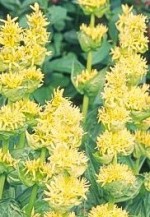 Yellow gentian, also called Bitterroot, has been around a long time. It was named for a 2nd century Illyrian king who is said to have used it to reduce fevers but it is mentioned in Egyptian writings about medicines dating to 1200 B.C. The ancient Greeks and Arabs used gentian to treat digestive and liver problems including intestinal worms and people in the Middle Ages used it as an antidote to poisons. Before the introduction of hops it was used in brewing and in more modern times is used is in the making of Angostura bitters. The root is the part most frequently used but the leaves and stems are also bitter.
Yellow gentian, also called Bitterroot, has been around a long time. It was named for a 2nd century Illyrian king who is said to have used it to reduce fevers but it is mentioned in Egyptian writings about medicines dating to 1200 B.C. The ancient Greeks and Arabs used gentian to treat digestive and liver problems including intestinal worms and people in the Middle Ages used it as an antidote to poisons. Before the introduction of hops it was used in brewing and in more modern times is used is in the making of Angostura bitters. The root is the part most frequently used but the leaves and stems are also bitter.
Type: Herbaceous medicinal herb
Bloom: Large, bright yellow flowers two inches across, are borne in whorls of three to ten in the axils of the upper leaves in mid summer.
Foliage: Leaves opposite, smooth, waxy, oval to oblong, up to one foot long and six inches wide; underside has five large prominent veins.
Size: 3-6’ H x 1’ W
Light: Full sun to partial shade
Soil: Humusy, rich, moist, well-drained
Hardiness: Zones 5-9
Care: Once established in a sight they like, need little care; top dress with acid soil or peat moss annually. Mulch in winter in cold areas where snow cover is lacking. Harvest roots in late summer or autumn. Dry slowly and thoroughly to retain bitterness and color. Good quality roots are dark reddish brown and taste sweet at first, then very bitter.
Pests and Diseases: None of significance
Propagation: Seeds (difficult to germinate); crown division (roots are very long so dig deeply).
